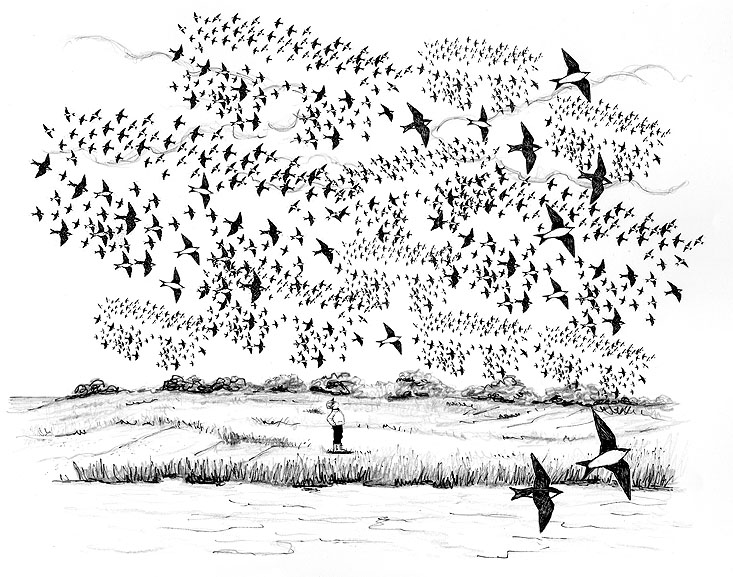
Dear Bird Folks,
This morning my husband and I were walking on Sandy Neck Beach when we came face to face with a massive flock of birds. However, these weren’t shorebirds, as we might have expected. They were all swallows, lots and lots of swallows. There must have been a gazillion of them. My questions are, why so many and why were they on the beach? I thought swallows lived around farms.
– Joyce, Barnstable, MA
Undoubtedly, the swallows that you saw were Tree Swallows. Like many humans, Tree Swallows love the beach. But unlike humans, who typically occupy our beaches after Memorial Day, Tree Swallows don’t arrive until after Labor Day, when parking is much easier. Also, like the summer crowd, these invading swallows aren’t just the locals; they come from all over New England, New York and Canada. Canadian swallows have been especially common in recent years, now that the exchange rate is in their favor.
The swallows that you saw were migrating. They are getting away before their breeding grounds become encased in snow and ice. What I find interesting is that these birds don’t fly directly south. It would seem to make perfect sense for a swallow born in, say, Bennington, VT, to wake up one morning, see that its daily planner reads “Migration Day” and make a beeline towards sunny Florida. Nope, that would be too easy. Like people who have to stop at a particular coffee shop before heading out on a road trip, Tree Swallows can’t fly south until they make a quick stop at the beach. Each fall thousands, maybe hundreds of thousands, and perhaps millions of Tree Swallows hug the coastline on their journey south. And fortunately for us, one of the places they like to stop on this journey is good old Cape Cod.
Why would a bird fond of farms and fields be attracted to the coast? The answer is bugs, of course. Even in the fall there seems to be plenty of biting gnats, mosquitoes, flies or beach fleas infesting the shoreline and the birds know it. In addition, coastal areas have another one of the swallows’ favorite foods, bayberries. You know those weird, little gray berries that early colonists somehow turned into scented candles? Well, Tree Swallows love them. Sometimes because of poor weather conditions, or whatever, insects aren’t available, so the birds use berries as their plan B.
This past August, when annoying Hurricane Irene was ripping through our area, I went down to the beach to look for birds that might have been blown in by the storm. In addition to seeing some very tired seabirds, I also saw a small flock of Tree Swallows. Irene’s winds prevented the insects from flying, so the swallows set their sights on bayberry bushes. Tree Swallows are one of the few birds that are able to digest the wax found in these berries. Their ability to digest bayberries not only allows the birds to find food during tough times, but it also means that they have some of the best smelling poop in the bird world. (Don’t ask me how I know that.)
During the breeding season Tree Swallows spend a lot of time and energy fighting with each other over nesting sites. Some of these fights can be quite aggressive. But once the birds have finished nesting, all is forgiven. In late summer swallows stream to coastal marshes where they form insanely large flocks. Over the years I have run into many of these jumbo flocks and they’ve always been memorable occasions. Remember, I’m not talking about a rowdy bunch of chattering blackbirds or quarreling starlings; these are swallows, thousand and thousands of delicate, tiny swallows. Typically the flock will silently appear like a wave of smoke drifting over the beach. The birds sometimes swirl around me so closely that I can hear the wind pass over their wings. It’s like standing in a giant snow globe of living birds. Just writing about it gives me goose bumps, or if you prefer, swallow bumps.
Seeing immense flocks of migrating swallows is not surprising, but what is surprising is that I don’t receive more calls about them. I get calls when people see too many Blue Jays, or too few goldfinches or anytime someone sees a bluebird; but the fall Tree Swallow migration, a true natural phenomenon, largely goes unreported. This is one of those events that is usually only seen on a National Geographic special, yet it occurs right down the road from where most of us live.
I know you have experienced this magnificent show, Joyce, but you’re one of the few. I think everyone else should take out their calendars right now and make a note to visit area beaches next September. While I can’t guarantee everyone will see one of these enormous flocks, I will guarantee that those who are lucky enough to see one will have an experience they won’t soon forget. They may even get a case of swallow bumps. If getting swallow bumps doesn’t motivate folks nothing will.